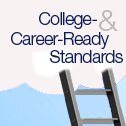Despite what it calls the notable progress by states in helping more students reach college- and career-readiness in recent years, there is still much work many states must do to turn a high school diploma into a meaningful accomplishment and not just a “ticket to nowhere.”
That’s the main message of “Closing the Expectations Gap,” a new report by Achieve, a Washington-based nonprofit that provides technical assistance to states on standards, assessment, and other policies, and played key roles in the launching the Common Core State Standards and the Next Generation Science Standards.

In the report released Jan. 29, Achieve says that the quality of testing has improved due to states’ adoption of common-core-aligned tests, Smarter Balanced and the Partnership for Assessment of Readiness for College and Careers (or PARCC, a testing consortium that Achieve used to manage). Achieve notes, however, that this progress, along with the adoption of higher standards, isn’t enough to ensure that students are truly prepared for life after high school.
To illustrate the frequent lack of alignment among standards, coursework and graduation requirements, Achieve looked at how diploma requirements in states line up with what courses students are required to take. You can see the results in the chart below. (CCR stands for college- and career-readiness.) Only 10 states and the District of Columbia, the group reported, make taking certain courses mandatory for high school graduation, while others provide for different paths to diplomas by allowing students to opt out of the CCR curriculum (“minimum opt-out” states), or opt out of individual courses of study on the college- and career-ready track (“personal modification” states):

In addition, 11 states offer courses of study that indicate college- and career-readiness, but students must “opt in” to those courses. The minimum diploma in these states (including California, Maryland, and Massachusetts) that doesn’t reflect that coursework does not, in turn, indicate readiness for life after high school. Achieve notes that because of the “opt in” feature, it is likely that many lower-income and minority students will miss out on college- and career-ready diplomas in these states.
A few other tidbits from the report:
• “11 states with CCR graduation requirements administer the ACT or SAT—tests that do measure college
readiness but are not necessarily well aligned with state standards.”
• “Of the 27 states that do not require students to complete a college- and career-preparatory curriculum but instead leave it optional for students, only six states (California, Maryland, Massachusetts, New York, Texas and Virginia) report how many graduates actually complete that course of study.”
“Fewer than half the states require high school students to take the courses that deliver those standards to earn a high school diploma, and this picture has not improved significantly in the last several years,” Achieve states near the end of the report. “The outlook for state assessments that measure CCR skills is understandably murky in this transitional year, further clouded by last-minute decisions in a number of states to abandon participation in Smarter Balanced or PARCC and launch a search for new assessments and assessment developers.”
There’s a lot more in the full report, which you can read below:
